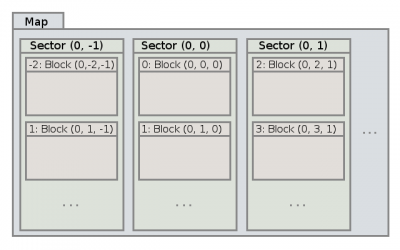Engine/NMPR
The base (NMPR)
Everything is built on a small core, that was the original network multiplayer release of Minetest (let's call it NMPR; the 2010-10-24 version). Being around 10000 lines of code, it contains:
- The Map: Voxel storage + lighting + rendering
- The Client + Server logic
- The Environment: Contains the map and the players, handles the simulation of the world
- The main loop: Invokes the client, the server, the environment and the rendering.
- A bunch of wrappers for OS-dependent things, and utilities.
As the current code still largely bases on the NMPR, it is useful to look at how it works.
Map (the voxels)
- The main content of the Map is a
map<v2s16, MapSector*>container. - The main content of a MapSector is
map<s16, MapBlock*>. - The main content of a MapBlock is a linear array of 16x16x16 MapNodes.
These form a relatively performant storage of voxel data. In addition to these containers, the latest fetched MapBlock is cached in each MapSector, and the last fetched MapSector is cached in Map, resulting in very useful sequential access speed through the whole abstraction layer.
Network protocol
The high-level network protocol of NMPR is delightfully simple. There are four commands for the server, and four commands for the client. Since this, a lot has been added and changed, but the basic idea stays the same.
Client -> Server
| TOSERVER_GETBLOCK | v3s16 p | Ask the server to send the data of a block |
| TOSERVER_ADDNODE | v3s16 p, MapNode node | Inform the server of a placed node |
| TOSERVER_REMOVENODE | v3s16 p, MapNode node | Inform the server of a removed node |
| TOSERVER_PLAYERPOS | v3s32 p*100, v3s32 speed*100 | Inform the server of the positon of the local player |
Server -> Client
| TOCLIENT_BLOCKDATA | v3s16 p, MapBlock data | Send the content of a block (16x16x16 nodes) |
| TOCLIENT_ADDNODE | v3s16 p, MapNode node | Add a node |
| TOCLIENT_REMOVENODE | v3s16 p, MapNode node | Remove a node |
| TOCLIENT_PLAYERPOS | foreach(player){
|
Update players on client |
Minetest uses it's own reliability layer on top of UDP. It isn't well documented at the moment, and thorough understanding of it isn't that important, so let's skip it as of now.
Environment
-
Rendering
-
